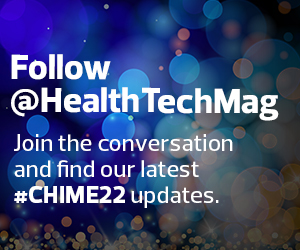From left to right: Moderator Liz Johnson, retired Tenet Healthcare CIO, appears on stage with John Glaser, Executive-in-Residence at the Harvard Medical School Executive Education; Theresa Meadows, Senior Vice President and CIO at Cook Children’s Health Care System; and Andrea Daugherty, Interim CIO at Dell Medical School at the University of Texas at Austin. Photo by Teta Alim
Lessons in Agility and Collaboration from the COVID-19 Pandemic
While Fort Worth, Texas-based Cook Children’s continues to see young patients in the emergency department for COVID-19 and flu-related illnesses, Meadows said that the experience in standing up drive-thru testing during the height of the pandemic improved her organization’s response speed.
“We’ve learned to be a bit more agile,” she said. “I think we’ve learned a lot over the last two years that’s really changed our industry in thinking about things a bit more differently and how we get things to market quicker.”
For Daugherty, the pandemic also spurred the growth of virtual collaboration — with staff working remotely and providers offering virtual care — and refining processes beyond a health crisis. How can healthcare IT attract talent from other industries with remote capabilities?
As a millennial, she says, she expects technology to be available, readily accessible and operational, and she hoped that mindset could become more widespread in healthcare:
“How do you take that mentality and bring it into an industry that’s historically laggard?”
DISCOVER: How digital transformation is taking off in healthcare.
The Evolving Healthcare IT Landscape
Meadows was positive about the changing industry, praising Daugherty and the next generation of healthcare IT leaders. “For those who’ve been in this industry for a while, it’s refreshing to have people who are thinking differently and really bringing new ideas to the table,” she said.
Earlier in his career, Glaser said it was common for other healthcare leaders to view IT as opaque and unknowable, but now that many have experienced the implementation of electronic health records, more executives have become discerning and inquisitive about IT.
“The CIO has gone from being a sport of the individual who’s carrying the organization across the finish line to a team sport,” Glaser said.
Still, the lack of diversity among healthcare IT leaders remains an ongoing issue. Daugherty hopes to be the leader that she needed when she first entered the field and realized just how white and male-dominated it is. “I’m happy to be the first, but hopefully I’m not the last, and that’s what’s important here,” she said.
When it comes to the technological aspect of the industry, Glaser said organizations are in an era of transformation that goes beyond a simple value-add to a brick-and-mortar business — it’s about retooling everything. And when the next phase arrives, it will be “digital, period,” he said, where organizations are no longer transforming to digital but are living and breathing it.
Click to gain access to exclusive HealthTech content from CHIME22 and beyond.















